Chronic Myeloproliferative Neoplasms (MPN)
What are Chronic Myeloproliferative Neoplasms or MPNs?
In myeloproliferative neoplasms (MPN), the bone marrow makes too many of one or more types of blood cells. Neoplasms usually get worse over time as the number of extra blood cells increases.
The six different types of MPN are generally defined by the type of cell which is most affected. They include:
- Chronic myelogenous leukemia (CML), the overproduction of white cells (granulocytes) and other cells
- Polycythemia vera, the overproduction of red blood cells and other cells
- Essential thrombocythemia, the overproduction of platelets and other cells
- Chronic neutrophilic leukemia, the overproduction of neutrophils (a type of white cell)
- Chronic eosinophilic leukemia, the overproduction of eosinophils (a type of white cell)
- Primary myelofibrosis, the gradual replacement of bone marrow tissue by fibrous scar-like tissue, disrupting normal blood cell production.
Relation to bone marrow failure diseases:
Myeloproliferative neoplasms and myelodysplastic syndromes are both blood cell diseases. In chronic myeloproliferative neoplasms, the bone marrow makes too many cells. In myelodysplastic syndromes, blood cells don’t mature and begin to fill the bone marrow.
Certain types of myeloproliferative neoplasms and myelodysplastic syndromes may become acute leukemia, another type of blood cancer.
What causes MPNs?
There are no known causes of MPN. There are, however, known risk factors that increase your chance of getting MPNs. These risk factors vary based on the MPN type you have:
- People over 60 are more likely to get myelofibrosis, polycythemia vera and primary myelofibrosis
- Men are more likely to get polycythemia vera, primary myelofibrosis and chronic myelogenous leukemia
- Women are more likely to get essential thrombocytosis
What are the symptoms of MPNs?
Some people with MPNs have no symptoms at diagnosis even though their blood counts are high. The symptoms depend on the type of MPN the patient has. Some of the more common symptoms include:
- Fatigue and tiredness
- Shortness of breath during exertion
- Pale skin
- Loss of appetite
- Weight loss
- Bone pain
- Night sweats
- Itching
- Infections and fever
- Pain or a feeling of fullness below the ribs from an enlarged liver or spleen.
- Weight loss without trying
- Blood clots
How do you diagnose MPNs?
Doctors usually discover MPNs when doing routine blood work or when evaluating patients with some of the symptoms above. There are a number of tests and tools doctors use to confirm a diagnosis and may include:
- Physical exam and history
- Blood tests:
- A complete blood count with a differential that looks at the total number and type of blood cells in your blood
- A blood smear that allows your doctor to look at your blood under a microscope
- Bone marrow examination including aspiration and biopsy to see how your bone marrow looks (required for diagnosis)
- Cytogenetic testing, which looks at abnormalities in your cell DNA
How do you treat MPNs?
Although myeloproliferative neoplasms cannot be cured, there are treatments for all patients with this condition. Some of them are:
- Chemotherapy, such as the drug hydroxyurea (known ashydroxycarbamide in Europe), can be given to patients with essential thrombocythemia and polycythemia vera to lower platelet and red blood cell counts.
- Anagrelide, which lowers platelet count
- Phlebotomy (periodic removal of blood intravenously) may be needed with polycythemia vera.
- Radiation therapy with high-energy rays or particles is sometimes used to relieve certain symptoms of MPN.
- Stem cell transplants, which replace blood-forming stem cells in the bone marrow with healthy stem cells from a donor
- Surgical removal of the spleen may be needed.
- Targeted therapies, such as imatinib, dasatinib, nilotinib, bosutinib, and ponatinib to treat chronic myelogenous leukemia or ruxolitinib to treat myelofibrosis or polycythemia vera, or imatinib and others to treat hypereosinophilia
Clinical trials, also called research studies, may offer good treatment options for some people myelofibrosis. These studies also help researchers better understand the value of promising new treatments or procedures.

